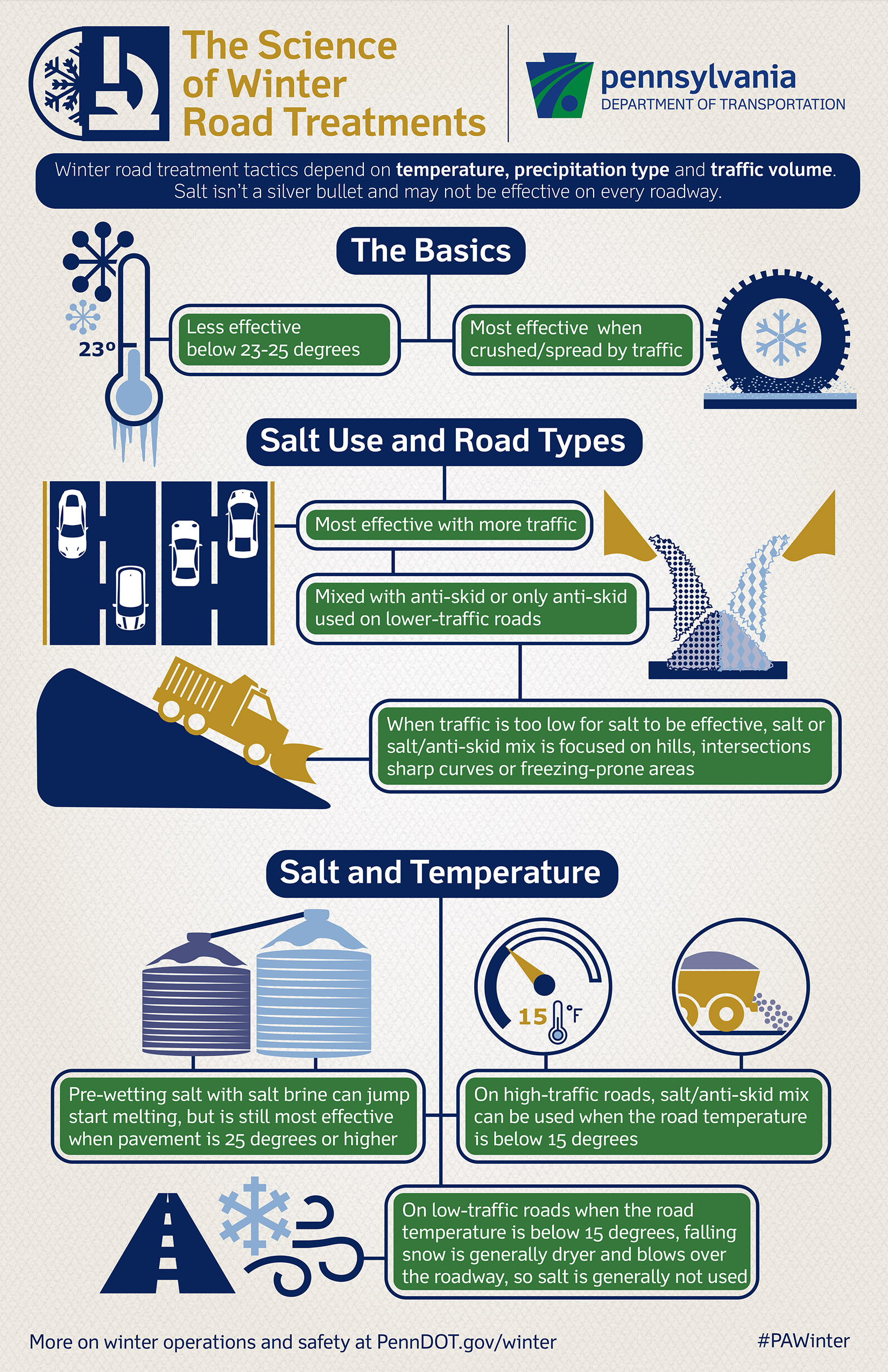Winter Operations
PennDOT maintains nearly 40,000 miles of roads and 25,400 bridges statewide, which translates into over 96,000 snow-lane miles — enough to circle the globe nearly four times! To tackle this task, PennDOT uses 2,211 trucks, plows, and salt spreaders, operated by about 4,700 on-the-road workers. The department also rents about 452 trucks and hires temporary operators to assist with snow removal operations. Over the past five winters, PennDOT has used an average of 801,453 tons of salt to keep Pennsylvania drivers moving.
If winter does strike, PennDOT will have crews treating roadways around the clock, but the department's aim is to keep roads passable rather than completely free of ice and snow. However, PennDOT will continue to treat roadways throughout the storm until precipitation stops and roads are clear.
Winter Maintenance
Winter operations include the removal of snow and ice, as well as applying deicing materials on all state highways and bridges. The heart of winter operations involves a skilled operator and a dump truck equipped with a salt spreader, snow plow, and often, a wing plow.
During severe winter storms, PennDOT also schedules at least one mechanic at each garage site to take care of any major equipment failures or breakdowns.
To prevent ice from building up on the road surface, PennDOT trucks spread a mixture of salt to melt the ice and small stones called anti-skid to provide traction. In some rural areas, PennDOT will limit salt and increase the amount of anti-skid spread over the road surface because salt depends on a certain amount of traffic to be fully effective.
During a storm, PennDOT will plow and salt major highways first before moving to the less-traveled rural roads. During severe winter storms, equipment is often redirected from assigned rural routes to assist with plowing heavily traveled roads first.
Another weapon that PennDOT has in its winter arsenal is anti-icing. Anti-icing essentially involves treating the road with brine (saltwater) before freezing precipitation starts to fall. The water part of the brine evaporates and the salt that remains helps prevent ice from forming a strong bond with the road surface.
PennDOT has 65 facilities statewide capable of making their own brine. In the 2021-22 season, we used 12.6 million gallons of salt brine.
Before the Storm
Department crews may pretreat with brine from the backs of anti-icing trucks before frozen precipitation starts to fall. However, salt brine is not a silver bullet and it isn't appropriate for every storm. Crews generally will not pretreat with salt brine when a storm is forecast to start as rain (rain will wash the material away) or when enough salt residue from a previous storm remains.
PennDOT also monitors weather forecasts to gauge when to call crews into action. Especially in high-traffic areas, PennDOT may stage plows along major routes and interstates so they can quickly begin treating the roadway when precipitation begins.
Some PennDOT regions use private contractors to supplement their state crews throughout the winter, while some areas only supplement their crews based on storm forecasts.
During the Storm
While snow is falling, roads will NOT be free of ice and snow. Why not? If snow is falling at 1 inch per hour, for example, and a truck takes three hours to return to the start of its route, 3 inches of snow has fallen.
Whether an operator is plowing snow from a roadway depends on the depth or heaviness of snow or slush, severity of the storm, and in what stage of the storm the truck is being operated.
During a storm, plows use the same roads we all travel on. As traffic or precipitation increases, so does the time it takes for a plow to complete its route.
If you're stuck in traffic, so are we. This means that if storms hit at rush hour, you should plan extra time for your commute.
PennDOT provides additional service to areas near schools and other large public gathering places.
Materials
 Click to view as PDF
Click to view as PDF
PennDOT plow operators use technology in their trucks to monitor air temperature and road temperature so they can tailor their road treatments on the go. The major factors that determine what material will be used on a roadway are temperature and traffic.
Because salt is most effective when traffic is crushing and spreading it on the road, the lower a road's traffic volume the more PennDOT will mix salt with anti-skid or other materials. Salt also isn't a silver bullet — it becomes less effective once temperatures dip below 23-25 degrees.
Higher Traffic Roads
Whether salt is pre-wetted or mixed with other materials during a storm depends on temperature, precipitation type, and a road's traffic volume.
A salt/anti-skid mix can be used when road surface temperatures are below 15 degrees, as straight salt and salt/chemical applications are less effective at lower temperatures.
On higher traffic roadways, PennDOT may also wet or pre-wet road salt with salt brine to jumpstart the salt's melting action. But even this tactic is most effective when the pavement temperature is 25 degrees or higher. Pre-wetting salt can also help keep salt on the road by reducing bouncing.
Lower Traffic Roads
On the state's lowest-traffic roadways, PennDOT will focus its salt/anti-skid usage on areas like hills, bridges, intersections, sharp curves, or freezing-prone areas. Because traffic volume is generally too low for salt alone to be effective on these roads, anti-skid will be mixed in to help with traction.
Anti-icing is generally not performed on low-volume roadways below 15 degrees because falling snow is generally drier and usually blows over the roadway surface.